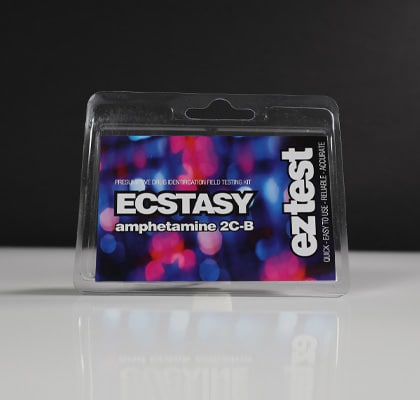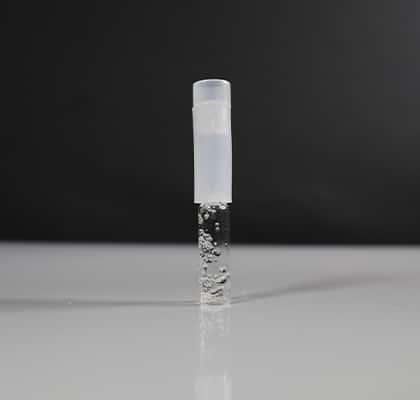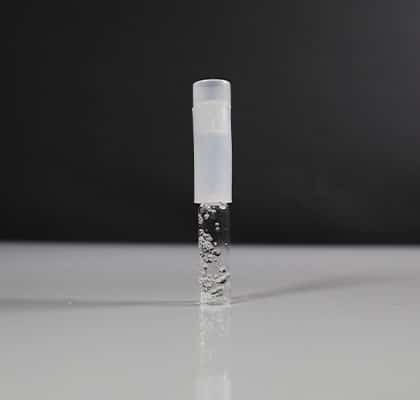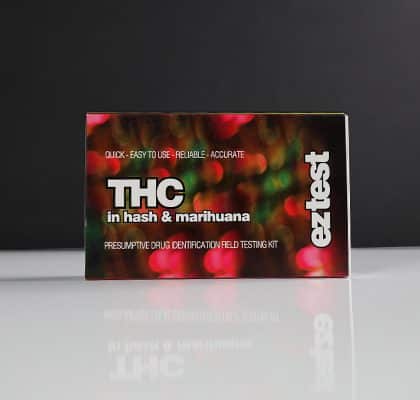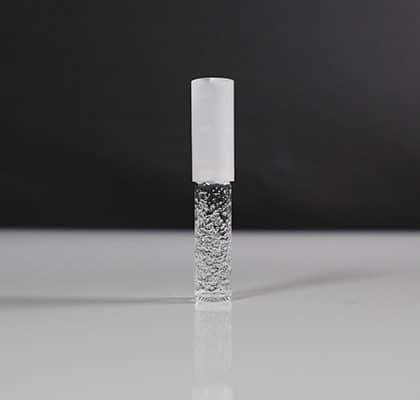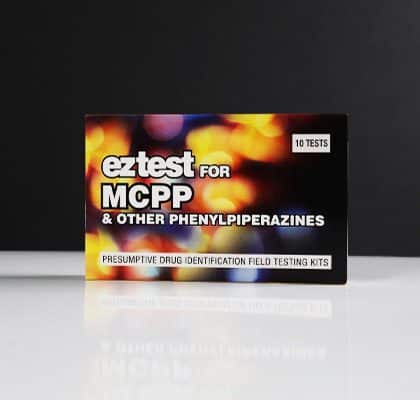XTC EZ-Test – One Pack
€4,00 Oorspronkelijke prijs was: €4,00.€3,00Huidige prijs is: €3,00. incl. vat
Empower yourself with the EZ Test Kit for XTC, amphetamine, 2C-B and more, a convenient single-use testing ampoule designed for harm reduction. This kit detects a range of psychoactive substances in pills or powders, helping identify potential adulterants to promote safer decisions and avoid dangerous side effects. Contains one single test.
What is EZ Test Kit for XTC, amphetamine, 2C-B and more
The EZ Test Kit for XTC, amphetamine, 2C-B and more is a single-substance detection tool featuring one ampoule, targeted at verifying the contents of ecstasy-like drugs. It responds to compounds including MDMA, MDA, MDE, MBDB, DXM, 2C-B, amphetamine, DOB, DOI, methylone, butylone, naphyrone, and opiates, generating specific color changes that can be cross-referenced with the included chart for quick identification. This kit tackles the widespread problem of impure street drugs, where tablets may include toxic additives causing issues like nausea, anxiety, sleeplessness, or life-threatening complications. Contains one single test.
Offering a rapid, home-based preliminary test, it acts as an entry-level screen to detect anomalies, though it isn’t a replacement for expert laboratory evaluation. Perfect for personal use in social or recreational environments, its compact design allows for easy carrying and subtle application. The ampoule format prioritizes convenience, slipping into any small space without bulk.
Users often seek this kit for reassurance, as it reveals the existence of anticipated ingredients while signaling discrepancies or voids. Its emphasis on harm minimization supports wider initiatives to reduce risks in uncontrolled supply chains, enabling more cautious participation.
History of EZ Test Kit for XTC
The EZ Test Kit for XTC, amphetamine, 2C-B and more originates from the escalation of drug testing needs in the late 1990s, during the height of rave and club scenes where ecstasy contamination became a major concern. MDMA’s origins date to 1912, but its recreational surge in the 1980s highlighted adulteration risks, inspiring grassroots harm reduction tools using basic reagents like Marquis for field checks.
This kit debuted as the first publicly accessible ecstasy tester in the early 2000s, pioneered by European firms adapting forensic methods for everyday consumers. It built on collaborations with groups like DanceSafe, honing reactions through real-world testing to encompass more substances like 2C-B derivatives. Evolutions included precise color guides, adapting to new synthetics entering markets.
Its single-pack variant caters to occasional users, reflecting demand for affordable, one-off options amid growing awareness. Over time, it has influenced policy discussions on safety, transitioning from niche to essential in global communities.
This progression illustrates a move from informal techniques to polished, accessible devices, championing education and precaution in psychedelic domains.
How to Use EZ Test Kit for XTC
To apply the EZ Test Kit for XTC, amphetamine, 2C-B and more, prepare a minute sample by scraping a bit from your tablet or powder to conserve material. Open the glass ampoule carefully per directions, avoiding pressure to prevent breakage. Add the sample to the reagent-infused silica gel inside, cap it, and agitate well to start the chemical interaction.
Watch for color shifts within minutes, matching them to the enclosed sheet and chart—distinct tones signal particular substances, such as purple for MDMA or variants for amphetamines. Absence of reaction implies no detected targets, urging vigilance.
Securely discard the ampoule and remnants in a closed vessel post-use to avert mishaps or pollution. Conduct in a bright, airy spot for clear observation, using sterile implements to dodge cross-contamination.
This efficient method requires little time, suiting impromptu verifications. Use the single ampoule wisely, recalling it’s suggestive only—lab confirmation is ideal for assurance.
Proper execution makes it a vital practice for safety-conscious individuals in substance handling.

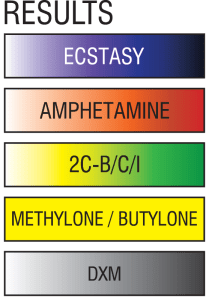
Ingredients of EZ Test Kit for XTC
The EZ Test Kit for XTC, amphetamine, 2C-B and more comprises a specialized reagent, often Marquis-inspired, embedded in silica gel for durability and measured dispensing. Encased in a solitary glass ampoule, this gel stabilizes active elements, safeguarding efficacy until employed. The reagent usually contains sulfuric acid alongside formaldehyde analogs, reacting with amines in drugs like MDMA to yield identifiable colors.
Lacking extraneous additives or pigments, it preserves emphasis on precise sensing sans disruption. Instructional aids like the color reference are supplementary, not integral to the reactive core.
Rooted in forensic traditions, this setup is fine-tuned for non-professional settings with scant quantity per unit. It poses low hazard when managed correctly, intended solely for external assays.
The mixture’s targeted nature distinguishes ecstasy relatives and affiliates, setting it apart from general-purpose testers. Clarity in makeup comforts exposure-wary users, underscoring risk mitigation focus.
Warning The EZ-Test can only give an indication of the substance in a sample. It does not provide a 100% guarantee. If you still have doubts about the ingredients of your product, have your product tested by an official agency. No right or claims can be derived from using the EZ-Test. Always read the instructions, don’t use force to open the ampoule. After testing, please remember to dispose of the ampoule and sample safely. The EZ testing kits are purely a guide to help analyze a substance. It is advised not to touch any substance and extensive laboratory testing of samples is recommended for more detailed results.
Do you ship to my country?
We ship to most EU countries. You can find these in the table below. We ship all our EU packages with DHL, DPD or PostNL depending on the area. This way we can deliver the best service possible. You will always receive a track and trace code to track your package from door to door.
| Country | Delivery | Costs | Free shipping |
|---|---|---|---|
| Austria | 2 - 3 | €11,95 | €125,- |
| Belgium | 1 - 2 | €7,95 | €125,- |
| Bulgaria | 6 - 8 | €21,95 | €125,- |
| Croatia | 3 - 5 | €17,95 | €125,- |
| Czech Republic | 2 - 4 | €13,95 | €125,- |
| Estonia | 4 - 6 | €19,95 | €125,- |
| France | 2 - 3 | €10,95 | €125,- |
| Germany | 1 - 3 | €7,95 | €125,- |
| Greece | 6 - 8 | €21,95 | €125,- |
| Ireland | 3 - 4 | €16,95 | €125,- |
| Italy | 2 - 4 | €18,95 | €125,- |
| Latvia | 3 - 5 | €15,95 | €125,- |
| Lithuania | 3 - 5 | €22,95 | €125,- |
| Luxembourg | 1 - 2 | €11,95 | €125,- |
| Netherlands | 1 - 2 | €6,95 | €125,- |
| Poland | 2 - 3 | €14,95 | €125,- |
| Portugal | 3 - 4 | €20,95 | €125,- |
| Romania | 3 - 5 | €17,95 | €125,- |
| Slovakia | 3 - 5 | €17,95 | €125,- |
| Slovenia | 2 - 3 | €17,95 | €125,- |
| Spain | 2 - 3 | €14,95 | €125,- |
* Difficult to reach areas like Islands or other remote regions will cost around €20,- more due to additional carrier fees.
Note: We try to ship all orders within 1 working day, all delivery times are estimated and can vary because of traffic and holidays.

